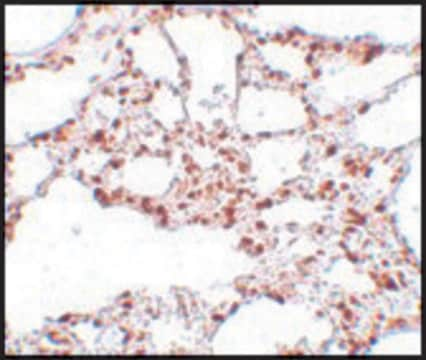AB4340
Anti-Zscan4 Antibody
from rabbit, purified by affinity chromatography
Synonym(s):
Zinc finger and SCAN domain containing protein 4C
About This Item
Recommended Products
biological source
rabbit
Quality Level
antibody form
affinity isolated antibody
antibody product type
primary antibodies
clone
polyclonal
purified by
affinity chromatography
species reactivity
mouse
technique(s)
immunofluorescence: suitable
immunoprecipitation (IP): suitable
western blot: suitable
NCBI accession no.
UniProt accession no.
shipped in
wet ice
target post-translational modification
unmodified
General description
Immunogen
Application
Immunoprecipitation Analysis: A 1:4,000 dilution from a representative lot detected Zscan4 in cytoplasmic and nuclear extracts in IP experiments conducted by the Melanie Welham lab at The University of Bath, UK. (Data not shown)
Epigenetics & Nuclear Function
Transcription Factors
Quality
Western Blotting Analysis: 0.2 µg/mL of this antibody detected Zscan4 in 10 µg of Embryonic Stem cell lysates.
Target description
Physical form
Storage and Stability
Analysis Note
Embryonic Stem Cell lysates
Other Notes
Disclaimer
Not finding the right product?
Try our Product Selector Tool.
Storage Class Code
12 - Non Combustible Liquids
WGK
WGK 1
Flash Point(F)
Not applicable
Flash Point(C)
Not applicable
Certificates of Analysis (COA)
Search for Certificates of Analysis (COA) by entering the products Lot/Batch Number. Lot and Batch Numbers can be found on a product’s label following the words ‘Lot’ or ‘Batch’.
Already Own This Product?
Find documentation for the products that you have recently purchased in the Document Library.
Our team of scientists has experience in all areas of research including Life Science, Material Science, Chemical Synthesis, Chromatography, Analytical and many others.
Contact Technical Service







